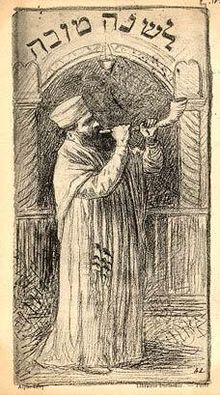Shofar
Like the modern bugle, the shofar lacks pitch-altering devices, with all pitch control done by varying the player's embouchure.
In the first instance, in Exodus 19, the blast of a shofar emanating from the thick cloud on Mount Sinai makes the Israelites tremble in awe.
On Rosh Hashana, the principal ceremony was conducted with the shofar, with the instrument placed in the center with a trumpet on either side; it was the horn of a ibex (a type of wild goat) and straight in shape, being ornamented with gold at the mouthpiece.
When the trumpets sound the signal, all the people who were within the Temple complex prostrate themselves, stretching out flat, face down, and on the ground.
It is blown each morning (and in some communities in the afternoon as well) during the month of Elul,[17] and to mark the end of the day of fasting on Yom Kippur, once the services have been completed in the evening.
[20] At the inception of the diaspora, during the short-lived ban on playing musical instruments, the shofar was enhanced in its use, as a sign of mourning for the destruction of the temple.
)[citation needed] The shofar is generally no longer used for secular purposes (see a notable exception in a section further down).
After the temple's destruction, the sounding of the shofar on Shabbat was restricted to the place where the great Sanhedrin was located.
It is played much like a European brass instrument, with the player blowing through the hole while buzzing the lips, causing the air column inside to vibrate.
Sephardi shofars do usually have a carved mouthpiece resembling that of a European trumpet or French horn, but smaller.
Because the hollow of the shofar is irregular in shape, the harmonics obtained when playing the instrument can vary: rather than a pure perfect fifth, intervals as narrow as a fourth, or as wide as a sixth may be produced.
Because of its inherent ties to the Days of Repentance and the inspiration that comes along with hearing its piercing blasts, the shofar is also blown after weekday morning services (in some communities, also at weekday afternoon services) for the entire month of Elul, the last month of the Jewish civil year, preceding Rosh Hashana.
Shofar blasts are also used in some communities during penitential rituals such as Yom Kippur Katan and optional prayer services called during times of communal distress.
[36] During the Ottoman and the British rule of Jerusalem, Jews were not allowed to sound the shofar at the Western Wall.
After the Six-Day War, Rabbi Shlomo Goren famously approached the Wall and sounded the shofar.
This fact inspired Naomi Shemer to add an additional line to her song "Jerusalem of Gold", saying, "a shofar calls out from the Temple Mount in the Old City.
[40] In pop music, the shofar is used by the Israeli Oriental metal band Salem in their adaptation of "Al Taster" (Psalm 27).
In the film version of the musical Godspell, the first act opens with cast member David Haskell blowing the shofar.
In his performances, Israeli composer and singer Shlomo Gronich uses the shofar to produce a wide range of notes.
Elmer Bernstein incorporated the shofar into several cues for his score for Cecil B. DeMille's The Ten Commandments; one of the shofar calls recorded by Bernstein was later reused by the sound editors for Return of the Jedi for the Ewoks' horn calls.
[citation needed] Jerry Goldsmith's scores to the films Alien and Planet of the Apes also incorporate the shofar in their orchestration.









